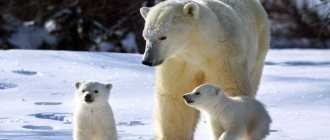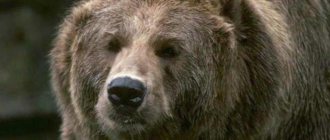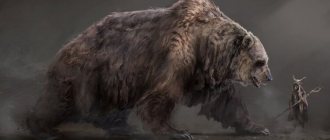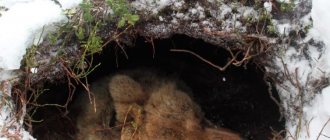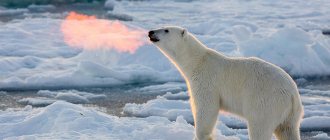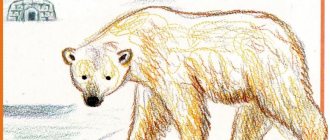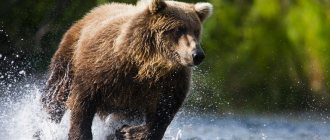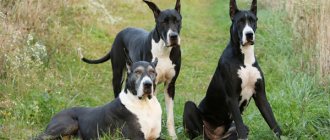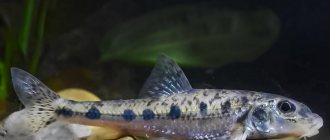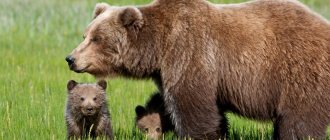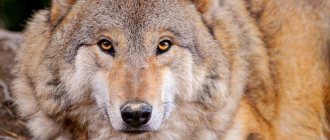Taxonomy.
Also on topic:
MAMMALS
The bear family is part of the order Carnivora and is divided into 4 subfamilies, one of which, Agriotheriinae, unites species that became extinct in the Pleistocene. The panda subfamily (Ailuropodinae), which includes the giant panda (bamboo bear) of China, has long been controversial among taxonomists, with some placing it in the raccoon family (Procyonidae) and others considering it a distinct family, Ailuropodidae. However, a more detailed study of anatomical features, as well as paleontological and molecular analysis data, made it possible to classify the giant panda as a bear. See also PANDAS.
In this volume, the family consists of five modern genera and eight species. The only species of the subfamily Tremarctinae lives in South America; the subfamily Ursinae with 3 genera and 6 species is distributed in North America, Asia and Europe. There are currently no bears in Africa, although representatives of the extinct subfamily Agriotheriinae once lived in the south of this continent, and one of the subspecies of the brown bear, Ursus arctos crowtheri, was found in the Atlas mountain range in Morocco and Algeria until the beginning of the 19th century. was completely exterminated.
Dimensions.
Also on topic:
SYSTEMATICS OF ANIMALS
The smallest bear is the Malayan (Helarctos malayanus), and the largest is the Alaskan brown (U. a. middendorffi) and white (U. maritimus). The total length of the first type can be approx. 1 m with a height at the withers of less than 68 cm (when the animal stands on four legs) and a weight of approx. 27 kg. The Alaskan brown bear is the largest land predator. Its length reaches 2.25 m (according to unconfirmed data - 2.8 m), height at the withers 1.3 m, and weight 770 kg. Standing on its hind legs, it can reach objects located at a height of 4.5 m. Polar bears can be up to 2.5 m long, with a height at the withers of up to 1.6 m and a weight of more than 770 kg.
Species and man
The bear has occupied people's imaginations for a long time. Because of the way it often rises on its hind legs, the bear is more like a human than any other animal. “Master of the forest” is how he is usually called. The bear is a character in many fairy tales; there are many sayings and proverbs about it. In them, this beast most often appears as a good-natured bumpkin, a slightly stupid strongman, ready to protect the weak. The respectful and condescending attitude towards this animal is evident from the popular names: “Mikhailo Potapych”, “Toptygin”, “clubfooted”... Comparing a person himself with a bear can be both flattering for him (“strong, like a bear”), and derogatory ( "Clumsy as a bear")
The bear is very common as a coat of arms; it is a symbol of strength, cunning and ferocity in defending the fatherland. Therefore, he is depicted on the coats of arms of many cities: Perm, Berlin, Bern, Yekaterinburg, Novgorod, Norilsk, Syktyvkar, Khabarovsk, Yuzhno-Sakhalinsk, Yaroslavl and others.
Reproduction and lifespan.
A female bear gives birth to offspring every two to three years. The mating season in most cases lasts from late spring to early summer (from June to early July in the Northern Hemisphere), although a brown bear may begin mating in April, and a white bear probably even in February. Pregnancy in a polar bear lasts on average 240 days (195–265), in a grizzly bear it lasts 208 days (180–250), and in a black bear it lasts 200–210 days.
Also on topic:
PREDATORY
However, the true development period of the embryo is shorter, since in bears it is not immediately implanted into the wall of the uterus, but after a considerable period - up to 6 months, and possibly more. The development of the embryo is suspended, then, after implantation, it is quickly completed. In black bears, an embryo conceived during June mating sometimes does not implant until November.
In the Northern Hemisphere, most bear cubs are born in January or February, although polar bears may be born in late November and brown bears in the Himalayas may not be born until May. A female bear brings from 1 to 5 cubs in a litter, and the first time usually one cub is born, and then more often twins are born. Cubs are born blind (eyes open after about 4 weeks), toothless, almost naked and helpless. Compared to their parents, they are very small and weigh from 227 to 453 g.
Usually cubs stay with their mother until her next pregnancy, i.e. about a year and a half, but sometimes they leave her after the first autumn or, conversely, stay for the entire second summer and longer. Sexual maturity occurs at the age of 2.5 to 4 years or even by 6 years, but bears, especially males, can begin to reproduce much later. Maximum size is reached several years after puberty. In nature, bears live up to 15–30 years, and a 20-year-old animal is considered old. In captivity, their life expectancy is much longer; A brown bear is known to have lived to be 47 years old.
Bears' vision and hearing are poorly developed
Photo: Becca
But they have a keen sense of smell and use their sensitive lips to search for and capture food. Black bears have color vision, and it has been shown to allow them to distinguish between food items at close range. Little is known about bear communication, but mooing, moaning and roaring are characteristic vocalizations of most species. Bear cubs can be especially loud, producing high-pitched howls when they are distressed. "Puffing" is used as a greeting by brown bears. Males may use scent signals to find receptive females.
Winter dream.
Some species of bears, especially those that live in areas with harsh winters, spend the coldest part of the year in a deep sleep in a den. Pregnant females give birth to cubs there, but males and non-pregnant females may not stop activity at all in winter, remaining “connecting rods”.
Bears' winter sleep is not real hibernation, since metabolic processes in the body do not slow down, and the animal is easy to wake up. For example, the American ground squirrel Spermophilus parryii goes into real hibernation. In the active state, its body temperature is close to 38 ° C, and during wintering it drops to almost 0 ° C. In a black bear that has fallen into winter sleep, the body temperature, which is approximately 38 ° C in summer, drops to 34–31 ° C.
Animal lifestyle and behavior
Brown bear and baribal are forest dwellers. The polar bear lives on drifting ice floes. And the Himalayan is a semi-arboreal animal.
Brown bears are solitary animals, with the exception of the female. who initially lives with young offspring. They are active mainly during daylight hours. In winter, brown bears hibernate.
You can guess that a polar bear has black skin just by looking at its feet.
Baribals are crepuscular animals leading a solitary life. In cold weather they go to their dens and hibernate.
Polar bears are nomadic animals with excellent hearing and sense of smell, allowing them to sense prey living underwater or located several kilometers away.
This polar bear living in a zoo is clearly bothered by the heat.
The Himalayan bear forages for food in the trees. But trees are not only a way for him to find food, but also to escape from enemies and harmful insects. Spends the winter season in hibernation.
In a foggy haze, polar bears cross the sea.
Evolution.
In the order of carnivores, bears are the youngest group, separated from ancient wolves in the late Miocene, ca. 10 million years ago or a little earlier. The first bears were similar to wolves in many ways.
The modern genus Ursus, known since the late Pliocene in Europe and Asia (about 3 million years ago), reached North America shortly thereafter. Its first representatives were small, the size of a modern Malayan bear, but in the Pleistocene era giant species also appeared. The largest of them, the cave bear (U. spalaeus), who lived in Europe, rivaled the Alaskan brown bear in size; it was almost as good as the first brown bears (U. arctos), which appeared in China ca. 400,000 years ago.
Remains of hundreds of thousands of cave bears have been found in Europe. The most amazing discovery was made in the Dragon Caves in Austria: the bones of approximately 30,000 of these animals were discovered here. Many of the bones belong to immature, sick or old individuals that died here during hibernation for centuries. Perhaps the reason for this was the weakening of the body in the previous summer due to illness, old age or lack of food.
The European cave bear became extinct approximately 12,000 years ago. Although people hunted it, it is unlikely that this is what led to the extinction of the species. Perhaps the decisive factor here was competition with the brown bear.
All types of bears have similar anatomical features
There are some minor differences, but all eight species of bears described in the previous paragraph of this article have approximately the same appearance: large torsos, massive limbs, narrow snouts, long hair, short tails and plantigrade walking (that is, bears, unlike most other mammals walk on the ground on their entire foot, just like humans). Most bears are also omnivores, eating a variety of animals, fruits and vegetables, with two important exceptions: the polar bear is largely carnivorous and hunts seals and walruses, while the giant panda eats only vegetation, mainly bamboo (though, oddly enough , its digestive system is relatively well adapted to digesting meat).
Spectacled bear
(Tremarctos ornatus) is the only representative of the family in South America. It lives mainly in the cool forests of the western macroslope of the Andes from western Venezuela and Colombia and possibly southern Panama to western Bolivia. The shaggy fur is black or blackish-brown in color, with whitish or yellowish markings on the face, where they surround the eyes like glasses, and on the throat and chest, where an irregular ring pattern forms. However, these spots are very variable, and in some individuals they are completely absent. The length of the spectacled bear reaches 1.8 m (plus a 7 cm tail), with a height at the withers of up to 76 cm and a weight of 140 kg. The animal is mainly herbivorous, preferring leaves, young shoots, fruits and roots of plants.
Malayan bear
(Helarctos malayanus), or biruang, lives in the tropical and subtropical forests of the foothills and mountains of Southeast Asia. It is distributed from northeastern India (Assam) and possibly southern and central China (Sichuan) through Myanmar, Thailand, Laos, Cambodia and Malaysia to Indonesia (Sumatra and Borneo). It has short, smooth black fur that usually fades to light brown on the legs and whitish or orange-yellow on the face; on the chest there is a large whitish or orange-yellow spot in the shape of a horseshoe. This marking, reminiscent in shape and color of the rising sun, explains the Latin name of the genus, meaning “sun bear.” The smallest representative of the family, it reaches a length of 1.4 m (plus a 5 cm tail) with a height at the withers of 70 cm and a weight of just over 100 kg. Feeds on lizards and other small vertebrates, insects and fruits; loves honey very much.
Sloth bear,
or “sloth bear,” so called for its slow gait; The Latin name (Melursus ursinus) indicates a love of honey (meli). The sloth fish lives in tropical and subtropical forests of India and Sri Lanka. It has long and shaggy fur, especially on the shoulders, which is mostly black but often mixed with grey, brown or reddish hair. Sometimes they predominate, and red or reddish-brown spongers are found. The muzzle is gray or yellowish. The claws are whitish. On the chest there is a distinct whitish, yellowish or reddish-brown spot, similar to the letter V or Y. The sloth bear, like the anteater, during evolution specialized in feeding on colonial insects. Its lips and muzzle are almost bare and very mobile, and its nostrils can close at will. The teeth are small, and the two central upper incisors are missing, creating a passage that continues the “tube” of elongated movable lips, necessary when extracting, for example, termites. Having opened the termite mound with its powerful claws, the bear closes its nostrils to prevent dust from getting into them, and loudly draws in air with its lips, sucking insects out of the nest. The sloth fish reaches a length of 1.8 m (plus a 12 cm tail) with a height at the withers of 91.5 cm and a weight of approx. 135 kg.
White-breasted bear.
The white-breasted bear (Ursus thibetanus), also called the Himalayan bear, is sometimes classified as a separate genus Selenarctos, which means “moon bear.” It inhabits hill and mountain forests and shrubs and is distributed from Iran through Afghanistan, Pakistan and the Himalayas in northern India to Korea and Japan. In the north, the range also covers northeast China (Manchuria) and the Primorsky Territory of Russia, and in the south it reaches northern Vietnam and the islands of Hainan and Taiwan. The fur is usually black, but individuals of a brownish or reddish color are also found. In addition to the whitish markings common on the muzzle and chin, there is always a white V-shaped patch on the chest; it resembles a crescent moon, and it is because of it that the bear is called the lunar bear. The animal reaches a length of 1.6 m (plus a 10 cm tail), a height at the withers of approximately 75 cm and a weight of approx. 120 kg. His diet is mainly vegetarian.
Lifestyle.
The life expectancy of bears is 25-40 years. They have practically no enemies. The only animal that can hunt a bear is the tiger. But he doesn’t really want to date him either. Bears can live in a variety of environments from steppes to arctic ice. They mainly live in forests of temperate and tropical latitudes. Some species are attached to water. If the Brown Bear can be found in the steppes, forests and sea coasts, then the Polar Bear lives only in the Arctic and is classified as semi-aquatic. The Malayan bear climbs trees well and builds nests on them. Bears are mainly active at night, but the polar bear is a diurnal animal. All of them are omnivores by nature of nutrition. But there are also those who prefer more plant foods (Panda) or animal foods (Polar Bear). There are species that hibernate in winter (Brown bear, Baribal and Himalayan). The rest do not sleep in winter.
Black bear.
Inhabiting most of the forest zone of North America, the black bear, or baribal (Ursus americanus), is distributed from northern Alaska across Canada to Labrador and Newfoundland, and in the south it reaches the central states of Mexico (Nayarit and Tamaulipas). Sometimes it is classified as a separate genus Euarctos. The fur is usually shiny black, brownish on the face and with a small white spot on the chest, but other color variations are known. The most common of them are shades of brown; Reddish-brown baribals are characteristic of the western United States. It happens that in one litter there are both black and brown bear cubs. Other color options: blue, more precisely, blue-black, with a brownish muzzle, and white or yellowish-white, with brown eyes. The blue form, found in the Yakutat Bay and St. Elias Mountains area of southeast Alaska, is known as the glacier bear. The white baribal, also called the Kermode or island polar bear, is found off the central coast of British Columbia on Gribble Island.
The animal reaches a length of approximately 1.8 m (plus a 15 cm tail) with a height at the withers of approx. 102 cm and usually weighs 90–135 kg, although some individuals weigh up to 270 kg.
Brown bear.
Once widespread in the Northern Hemisphere, the brown bear (Ursus arctos) was common throughout Europe, reaching northwest Africa, and through Siberia and China reaching Japan. It came to North America from Asia via the Bering Isthmus, possibly ca. 40,000 years ago and spread widely across the western part of the continent from Alaska to northern Mexico. Today, while remaining a fairly common species in Scandinavia, Russia, Syria, and in places in China, Alaska and northwestern Canada, it has been extirpated from much of its former range. In Europe, predominantly isolated populations remain in the Pyrenees, the Alps, central Italy and the Carpathians. In Japan, the animal is still found on the island of Hokkaido.
It was once thought that the group of brown bears was quite heterogeneous. In North America alone, it was divided into approximately 80 independent species. Today, although population differences exist and are generally recognized, they are not given as much importance, and all brown bears are grouped into one widespread species with many geographic races or subspecies. Such are, for example, the grizzly bear (U. a. horribilis) and the Alaskan brown bear (U. a. middendorffi), which were once distinguished as separate species (the subspecific rank of the taxon is indicated by the third word in the Latin name). American brown bears, once common from Alaska to Texas and northern Mexico, are now found only in Alaska, western Canada (Yukon, western Northwest Territories and Alberta, British Columbia), Idaho, Montana and Wyoming. The California grizzly bear, featured on the California flag, became extinct around 1925.
The fur color of a brown bear varies from creamy white through various shades of brown to bluish and almost pitchy black. In Europe the brown form is common. In North America, all varieties are found, from yellowish to almost black. The hair, especially on the back, may be white at the end, giving the appearance of a gray or gray shade. Such a fur coat is typical not only of the American grizzly bear, but also of the brown bear in the Tien Shan mountains. Entirely grayish-white hair is found in brown bears in the Himalayas, and pale reddish-brown hair is found in Syria.
Within its range, the size of the animal varies. Grizzlies reach a length of 2.1 m with a height at the withers of more than 1 m and a weight of up to 385 kg. The length of the European brown bear is usually 1.25–2.0 m with a height at the withers of approx. 1 m and weighing from 135 to 250 kg.
The role of bears for the ecosystem and humanity as a whole is positive
Bears are important members of healthy ecosystems and are sometimes used as an indicator of the health of habitats and wildlife. All species of bears, due to their omnivorous nature and large size, influence carnivore populations and plant communities in the ecosystems in which they live. Polar and brown bear populations that depend on large prey put significant pressure on breeding seal and moose populations. Almost all species of bears help disperse seeds from the fruits they eat.
Bears have been hunted by people throughout history for their meat, fat, and fur. Other parts of the body, especially gall bladders, are used in traditional Chinese pharmacopoeia, although their usefulness in treating diseases has never been scientifically proven. Research into the metabolic pathways that black bears use during winter torpor could help develop treatments for kidney failure, gallstones, severe burns and other diseases.
Bear cubs are quite easy to tame, so they are usually used in circus performances. This has often led people to view bears as tame and harmless animals rather than as potentially dangerous creatures deserving of caution and respect. This mistake often led to tragedies.
Grizzlies and polar bears are the most dangerous. They regularly attack and kill people when they feel threatened. Bear attacks that initially appear to be unprovoked are often found to be unprovoked upon investigation. Bears that live near people or are accustomed to people cause damage by entering homes, grocery stores and gardens. Some species damage crops. Bears are often implicated in livestock predation, although their impact on livestock populations is often greatly exaggerated.
Polar bear.
The polar bear (Ursus maritimus) is sometimes classified as a separate genus, Thalarctos. He lives in the Arctic. The species' range changes in accordance with seasonal changes in the polar ice boundary: in summer it retreats along with them closer to the pole, and in winter it expands to the south. Although the polar bear stays mainly on the coast and floating ice floes, in winter it can lie in a den on the mainland, sometimes 50 km from the sea. In summer, animals also wander quite far from the coast in search of berries, bird eggs and other food.
Characteristic features that distinguish the polar bear from its relatives are relatively long legs, a narrow chest, a long neck and a rather small flat head. The skin, nose, lips, paw pads and eyes are black, and the coat color varies from white or grayish to yellowish or yellowish-red. The shade of a fur coat often depends on the season, age (bear cubs have whiter fur coats than adults) and other factors, for example, in summer the fur may turn yellow due to constant exposure to sunlight.
Polar bears come in very large sizes. The smallest animals are found on Spitsbergen, and as they move west through Greenland and North America to the Bering Sea, their size increases. A similar size gradient can be traced eastward from Spitsbergen through Siberia to the Bering Sea. The average length of males is approx. 2.2 m, but varies from 1.9 to 2.4 m. Bears are smaller, usually 1.8 to 2.0 m long. Tail length in both sexes is from 8 to 13 cm. Height at withers 0.9– 1.2 m, but in particularly large males it reaches 1.6 m. The weight of adult males is usually 360–400 kg, although it varies from 300 to 800, and adult female bears average 320 kg, but sometimes only 160 kg.
